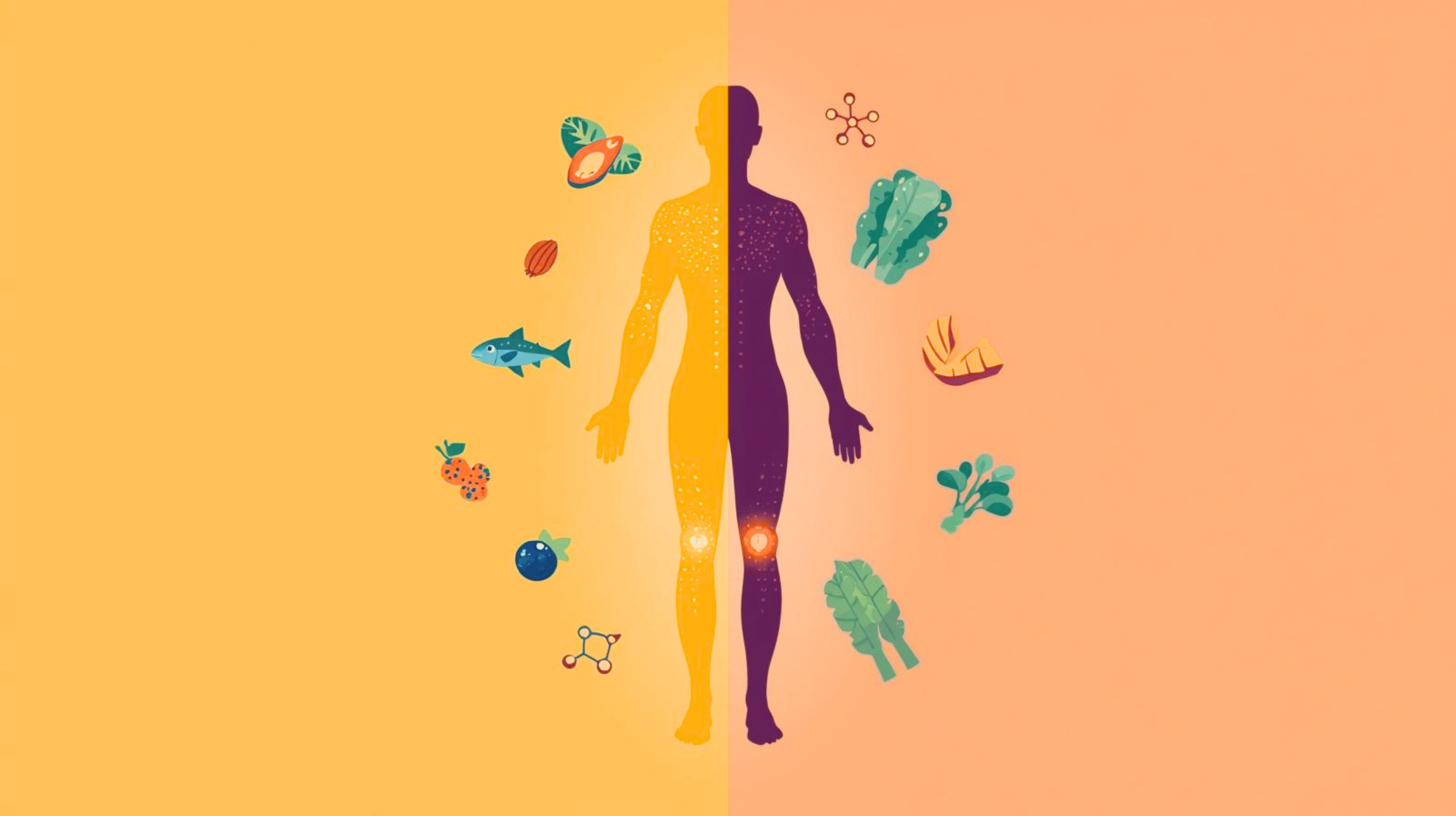Healthy skin and strong joints are essential indicators of overall wellness and longevity. Skin not only serves as the body’s protective barrier but also reflects nutritional status, hydration, and aging. Similarly, joint health affects mobility, physical activity, and quality of life. Nutrition plays a pivotal role in maintaining skin elasticity, reducing inflammation, and supporting joint function. Adequate intake of vitamins, minerals, antioxidants, and specialized nutrients helps prevent premature skin aging, promotes tissue repair, and maintains cartilage integrity [1]. This article explores the essential nutrients for skin and joint health, their dietary sources, and practical strategies to incorporate them into daily life.
Understanding Skin and Joint Health
To effectively support skin and joint health through nutrition and lifestyle, it is important to understand their structure, function, and common challenges. Both skin and joints are dynamic systems influenced by internal factors, external stressors, and aging.
1. Skin Structure and Function
The skin is the largest organ of the body, accounting for approximately 15% of body weight. It serves as the primary barrier against environmental insults such as UV radiation, pathogens, and toxins, while also regulating temperature and hydration. The skin consists of three main layers:
- Epidermis:
- The outermost layer, composed primarily of keratinocytes.
- Responsible for barrier function, protection from pathogens, and retention of moisture.
- Contains melanocytes, which produce melanin to protect against UV damage.
- Dermis:
- The middle layer, rich in collagen and elastin fibers, which provide structural support, elasticity, and resilience.
- Contains blood vessels, nerves, sweat glands, and hair follicles.
- Responsible for nutrient delivery and waste removal through the vascular system.
- Hypodermis (Subcutaneous Layer):
- Composed mainly of fat and connective tissue.
- Provides cushioning, insulation, and shock absorption.
- Plays a role in maintaining skin firmness and volume.
Key Components for Skin Health:
- Collagen: Provides tensile strength and prevents sagging. Levels decline with age, leading to wrinkles and thinning skin.
- Elastin: Maintains skin elasticity and flexibility.
- Hyaluronic Acid: Helps retain moisture, keeping skin plump and hydrated.
- Sebum and Natural Oils: Protect against dryness and environmental damage.
2. Joint Structure and Function
Joints are crucial for mobility, supporting daily activities and overall physical function. Understanding joint anatomy helps explain how nutrition and lifestyle choices impact joint health:
- Cartilage:
- Smooth, flexible tissue that covers bone ends, reducing friction during movement.
- Composed of collagen and proteoglycans, cartilage lacks a direct blood supply and relies on nutrients from synovial fluid.
- Synovial Fluid:
- Lubricates joints, nourishes cartilage, and absorbs shock.
- Contains hyaluronic acid, which contributes to viscosity and cushioning.
- Ligaments and Tendons:
- Ligaments connect bone to bone, providing joint stability.
- Tendons connect muscles to bone, enabling movement [2].
- Both structures are collagen-rich and benefit from protein intake and amino acids.
- Bursa:
- Fluid-filled sacs that reduce friction between bones and soft tissues.
Importance of Nutrition for Joint Health:
- Adequate protein, amino acids, vitamins, and minerals support cartilage repair and tendon/ligament integrity.
- Anti-inflammatory nutrients reduce oxidative stress in joint tissues, preventing stiffness and discomfort.
2. Common Skin and Joint Challenges

Understanding the common challenges that arise with aging or poor lifestyle choices helps in designing preventive strategies:
Skin Challenges:
- Dryness: Caused by reduced oil production and dehydration.
- Wrinkles and Loss of Elasticity: Decline in collagen and elastin with age.
- Premature Aging: Oxidative stress from UV exposure, pollution, and free radicals accelerates aging.
- Hyperpigmentation: UV damage or inflammation can lead to uneven skin tone.
Joint Challenges:
- Stiffness and Reduced Mobility: Often due to cartilage wear, inflammation, or lack of physical activity [3].
- Inflammation and Pain: Osteoarthritis or overuse injuries trigger inflammatory responses.
- Loss of Cartilage and Bone Density: Aging and nutrient deficiencies increase the risk of osteoarthritis and osteoporosis.
Essential Nutrients for Healthy Skin
1. Vitamins for Skin Health
- Vitamin C: Critical for collagen synthesis, antioxidant protection, and skin repair. Citrus fruits, berries, bell peppers, and broccoli are rich sources.
- Vitamin E: Protects against oxidative damage and UV-induced skin aging. Found in nuts, seeds, and vegetable oils.
- Vitamin A: Supports skin cell turnover, repair, and barrier function. Sources include sweet potatoes, carrots, and leafy greens.
Vitamins also enhance immune defense, aiding the skin in fighting infections and inflammation.
2. Minerals for Skin
- Zinc: Plays a role in wound healing, inflammation control, and acne prevention. Found in pumpkin seeds, legumes, and seafood.
- Selenium: Provides antioxidant protection, preventing cellular damage from free radicals. Sources include Brazil nuts, eggs, and fish.
3. Antioxidants and Phytonutrients
- Polyphenols, flavonoids, and carotenoids protect against oxidative stress, inflammation, and UV-induced skin damage.
- Benefits: Reduce premature aging, maintain skin tone, and improve skin elasticity. Foods like green tea, berries, and colorful vegetables are rich in antioxidants.
4. Hydration and Fatty Acids
- Omega-3 fatty acids: Support skin hydration, reduce inflammation, and enhance barrier function. Found in fatty fish, flaxseeds, and walnuts.
- Healthy fats: Avocado, olive oil, and nuts provide essential fatty acids, promoting supple, radiant skin.
- Hydration: Adequate water intake maintains cellular function and skin elasticity.
Essential Nutrients for Joint Health
1. Collagen and Amino Acids
- Collagen peptides support cartilage repair, flexibility, and joint integrity.
- Amino acids glycine, proline, and lysine are essential for connective tissue synthesis.
- Collagen-rich foods: bone broth, lean meats, and gelatin.
2. Vitamins Supporting Joints
- Vitamin D: Enhances calcium absorption, bone strength, and joint function. Sources include sunlight, fatty fish, and fortified foods.
- Vitamin K: Supports bone mineralization and joint integrity. Found in leafy greens and fermented foods.
3. Minerals for Joint and Bone Strength
- Calcium and magnesium: Essential for bone density and preventing osteoporosis. Sources: dairy, leafy greens, legumes.
- Phosphorus and manganese: Crucial for cartilage formation and maintenance.
4. Anti-Inflammatory Nutrients
- Omega-3 fatty acids: Reduce joint inflammation and stiffness.
- Curcumin and antioxidants: Combat oxidative stress in joint tissues, reducing the risk of arthritis. Turmeric, berries, and green tea are rich sources.
5. Specialized Supplements
- Glucosamine and chondroitin: Support cartilage health and joint mobility.
- Hyaluronic acid: Maintains synovial fluid viscosity, cushioning joints.
- Supplements should be used under professional guidance.
Dietary Sources and Meal Planning for Skin and Joint Health
Proper nutrition is the cornerstone of maintaining healthy skin and strong joints. A well-planned diet ensures that your body receives all the essential nutrients needed for collagen synthesis, antioxidant defense, and joint integrity [4].
1. Fruits and Vegetables
- Fruits and vegetables are rich in vitamins, minerals, antioxidants, and phytonutrients that support skin elasticity and reduce inflammation.
- Vitamin C found in citrus fruits, strawberries, and bell peppers is crucial for collagen formation.
- Carotenoids in carrots, sweet potatoes, and tomatoes protect skin from oxidative stress and promote a youthful appearance.
- Green leafy vegetables, such as spinach and kale, provide vitamin K and magnesium, which help maintain bone and joint health.
2. Protein-Rich Foods
- Proteins supply amino acids necessary for collagen synthesis and tissue repair.
- Lean meats, poultry, fish, and eggs are excellent sources of glycine, proline, and lysine, which support connective tissue maintenance.
- Legumes, lentils, and soy provide plant-based protein options for vegetarians and vegans.
3. Omega-3 and Healthy Fats
- Omega-3 fatty acids reduce joint inflammation and improve skin hydration. Sources include salmon, mackerel, flaxseeds, chia seeds, walnuts, and olive oil.
- Monounsaturated fats from avocado, nuts, and seeds help maintain skin suppleness and support hormone balance necessary for joint health.
4. Dairy and Calcium-Rich Foods
- Calcium and magnesium are vital for bone strength and cartilage support.
- Dairy products (milk, yogurt, cheese), fortified plant milks, almonds, and tofu are excellent sources.
- Including these foods helps prevent osteoporosis and joint degeneration.
5. Collagen-Rich Foods
- Bone broth, gelatin, and collagen peptides provide structural proteins for skin firmness and joint flexibility.
- Regular consumption supports cartilage repair, reduces joint discomfort, and enhances skin elasticity.
6. Meal Planning Tips
- Include a variety of colorful vegetables and fruits in every meal.
- Combine protein and healthy fats to improve nutrient absorption.
- Plan snacks with nuts, seeds, and fruits to maintain antioxidant intake throughout the day.
- Consider smoothies with leafy greens, fruits, and collagen powder as a convenient nutrient boost.
- Balance calorie intake with physical activity to maintain overall health and reduce inflammation.
Lifestyle Factors Enhancing Skin and Joint Health
Beyond diet, lifestyle habits significantly influence skin and joint health. Integrating these habits enhances nutrient absorption, reduces oxidative stress, and supports tissue repair [5].
1. Regular Exercise
- Strength training maintains muscle mass, supports joint function, and reduces cartilage wear.
- Low-impact exercises like swimming, cycling, and yoga improve flexibility and joint mobility.
- Cardiovascular activity enhances circulation, delivering oxygen and nutrients to skin and joints efficiently.
2. Adequate Hydration
- Water is critical for maintaining skin elasticity and supporting synovial fluid in joints.
- Drinking at least 8–10 glasses of water daily prevents dryness, improves skin plumpness, and lubricates joints to reduce stiffness.
- Hydrating foods, such as watermelon, cucumber, and oranges, complement fluid intake.
3. Sun Protection
- Excessive UV exposure accelerates skin aging and collagen breakdown.
- Use sunscreen, wear protective clothing, and avoid peak sunlight hours to maintain healthy skin.
- Antioxidant-rich foods, like berries and green tea, provide internal protection against free radical damage.
4. Avoiding Smoking and Excess Alcohol
- Smoking depletes vitamin C and damages collagen, accelerating skin aging.
- Excess alcohol dehydrates the skin, triggers inflammation, and impairs nutrient absorption for bone and joint health.
- Limiting or avoiding these substances improves overall tissue health and reduces oxidative stress.
5. Stress Management
- Chronic stress elevates cortisol, leading to inflammation and collagen breakdown.
- Practices like mindfulness, meditation, yoga, or breathing exercises help lower stress levels.
- Engaging in hobbies, social interactions, and positive experiences also enhances skin repair and joint wellness.
6. Sleep and Recovery
- Adequate sleep (7–9 hours) allows cellular repair and collagen production.
- Poor sleep is linked to increased inflammation, reduced skin elasticity, and joint stiffness.
- Establishing a consistent sleep routine enhances nutrient utilization and overall recovery.
7. Weight Management
- Maintaining a healthy weight reduces stress on joints, particularly knees, hips, and spine.
- Excess weight accelerates cartilage breakdown and increases inflammation.
- Combining balanced nutrition, regular exercise, and mindful eating supports both skin and joint health.
Conclusion
Skin and joint health are closely tied to diet, nutrients, and lifestyle habits. Adequate intake of vitamins, minerals, antioxidants, healthy fats, and specialized supplements helps maintain elasticity, reduce inflammation, and support overall mobility. Combined with regular exercise, hydration, sun protection, and stress management, these strategies foster long-term wellness and youthful skin and joint function.
Looking for more health and wellness solutions? Don’t miss these related guides:-
- How microbreaks and lumbar support together can save your spine
- How pillow height affects sleep quality
Frequently Asked Questions:
1. Which nutrients are most important for healthy skin?
Vitamin C, vitamin E, vitamin A, zinc, selenium, omega-3 fatty acids, and antioxidants like polyphenols and carotenoids are key for maintaining skin elasticity, hydration, and protection against oxidative stress.
2. How do vitamins and minerals support joint health?
Vitamin D, K, calcium, magnesium, and phosphorus strengthen bones and cartilage, while amino acids and collagen peptides maintain connective tissue integrity.
3. Can omega-3 fatty acids reduce joint inflammation?
Yes, omega-3s from fish, flaxseed, and walnuts reduce inflammation, improving joint mobility and reducing stiffness.
4. What are the best dietary sources of collagen?
Bone broth, lean meats, chicken skin, and gelatin-rich foods supply collagen and amino acids essential for connective tissue.
5. How does hydration affect skin and joint function?
Adequate water intake maintains skin plumpness and elasticity and ensures proper synovial fluid production for joint lubrication.
References
- Calder, P. C. (2015). Functional roles of fatty acids and their effects on human health. Journal of Parenteral and Enteral Nutrition, 39(1 Suppl), 18S–32S. https://aspenjournals.onlinelibrary.wiley.com/journal/19412444
- Ganceviciene, R., Liakou, A. I., Theodoridis, A., Makrantonaki, E., & Zouboulis, C. C. (2012). Skin anti-aging strategies. Dermato-Endocrinology, 4(3), 308–319. https://www.tandfonline.com/doi/full/10.4161/derm.22804
- McAlindon, T. E., Nuite, M., Krishnan, N., et al. (2011). Glucosamine and chondroitin for treatment of osteoarthritis: Current evidence. Arthritis & Rheumatism, 63(5), 1469–1475. https://onlinelibrary.wiley.com/doi/10.1002/art.30233
- Pilkington, S. M., Watson, R. E. B., Nicolaou, A., & Rhodes, L. E. (2011). Omega-3 polyunsaturated fatty acids: Photoprotective macronutrients. Experimental Dermatology, 20(8), 537–543. https://onlinelibrary.wiley.com/doi/10.1111/j.1600-0625.2011.01346.x
- Zdzieblik, D., Oesser, S., Gollhofer, A., & König, D. (2015). Collagen peptide supplementation in combination with resistance training improves body composition and increases muscle strength in elderly sarcopenic men. The British Journal of Nutrition, 114(8), 1237–1245. https://www.cambridge.org/core/journals/british-journal-of-nutrition/article/increased-intake-of-vegetable-oil-rich-in-n6-pufa-enhances-allergic-symptoms-and-prevents-oral-tolerance-induction-in-wheyallergic-mice/F045A57257DA164CA648F48B3F613359



















